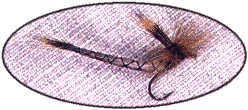A common method for fishing smallmouth streams is to float
the stream in a canoe until a likely-looking spot is found,
then beach the conoe and fish the area thoroughly from
shore or by wading in the river. When you have finished
with that particular spot, the canoe is used to move to the
next. It is easier to cover many miles of stream in this
manner than to try to wade or walk the same distance.
I like to use a floating nymph in June and July and then again
later in the fall when the fish might encounter seasonal emergences
of what is known as the tiny western olive mayfly. Though this
particular mayfly is most common in the West, the floating nymph
has proven effective across the country for bass fishing.
Maybe bass aren't as selective as trout, or maybe the nymph
suggests another organism that bass like to eat, but whatever
the reason, floating nymphs deserve a place in your smallmouth
fly box.
This particular pattern actually is representative of the
stage of the nymph that occurs just prior to its hatching
into an adult insect. I like to cast it upstream and let it
be carried downstream on or just below the surface when the
current is moving near the stream bank.

One of my favorite dry flies to use for smallmouths
is the Paradrake. It is a floating parachute-type dry fly that
imitates the western green drake and other large mayflies. It
has proven to be effective on ponds, lakes, reservoirs, creeks,
streams and rivers, wherever cool, clear water is found near
aquatic vegetation.
I like to cast the fly as close to standing vegetation as
possible and let it sit several seconds before skating it a few
inches across the surface. If that doesn't produce a strike, I
recast to another location a few inches away. By castingh and
changing position often, I can work an area thoroughly and tempt
every fish in the vicinity. I may not get them all to strike, but
at least I'm confident they have seen the fly and been given the
opportunity to hit it.
When I'm fishing the paradrake in a stream, I cast it upstream
along the outside edge of a line of vegetation and let it ride the
current downstream as close to the weeks as possible. This tactic
works especially well in spots where the current is very slow.
Sometimes it produces very swift, slashing, dramatic strikes;
while other times a bronzeback will rise warily like a trout and
just suck the fly from the surface.
In faster moving water I cast the fly upstream and try to
place it so the current floats it around, past and behind
submerged rocks or other obstructions where smallmouths are apt
to be waiting for a snack to be served.
~ Tom Keith
|



